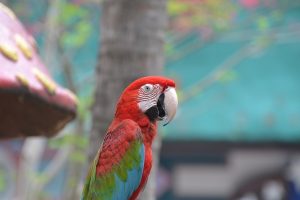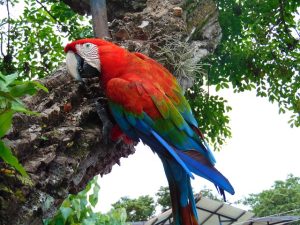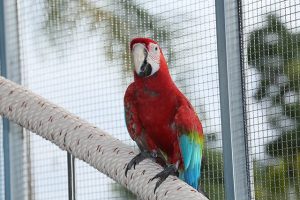Many people also know the Red and green macaw as a green-winged macaw. These parrots continue their life in 2 ways – wild and captivity. But, How long does a red and green macaw lifespan in captivity?
A Green-winged Macaw has an average lifespan of 60 to 80 years. The green-winged macaw has more than 70 years of a lifetime if properly kept and cared for. Its beauty will most likely stun you. Their vivid colors, peaceful attitude, and long lifespan attract animal enthusiasts from all over the world.
Let’s talk about how long macaws live in captivity and what you can do to ensure yours has a long and happy life.
Red and Green Macaw- Overview:

| Height | 2-3.7 pounds- Weight |
| Lifespan | 30-60 years |
| Distribution | ● South America
● Found in Brazil, Peru, Ecuador, Guyana, and others. |
| Population size | 50-500 THOU |
| Top speed | 56 KM/H |
| Weight | 2-3.7 pounds. |
| Wingspan | 104-125 CM |
| Seasonal Behavior | Not a migrant |
| Reproduction season | December |
| Independent age | 3-4 months |
| Incubation period | 28 days |
Red and Green Macaw-Morphology:
- Mainly deep red
- The top part of the wing feathers is red, the upper and middle sections are green, and the bottom region is teal or light blue.
- Its top wing feathers are mostly green.
- A white-faced bird with crimson feathers around its eyes.
- The world’s second-largest macaw
- The beak is long and curved.
A macaw’s life expectancy in captivity
A captive macaw parrot may outlive many humans. There are, however, multiple subspecies. Some smaller subspecies do not live as long as their larger counterparts. They may, however, outlast other pets, such as cats and dogs. If you want a macaw in your house for 25 to 60 years, you should expect him to be everywhere.
What’s a macaw’s average lifespan?
Red-and-green macaws live an average of 51 years in captivity. In 2008, the greatest reported longevity in captivity was 63.04 years.
Young et al. (2012) computed lifespans from hatching day 1. The average lifespan was 9.51 years. However, if macaws had been held captive for at least four years, their average lifetime was 14.44 years.
As previously stated, they may have substantially shorter lives in captivity than in the wild! Why is this the case? On the other hand, poor care and ignorance about their requirements have a significant impact.
As with other parrots, many (beginning) enthusiasts buy a macaw without enough preparation. They may fail to seek knowledge on food, housing, and socializing, all of which are critical to a macaw’s happiness.
Rather than debating probable lifespans, let’s focus on what you can do to guarantee that yours lives a long and healthy life!
Care tips for living a long life:
Green-winged macaws are considered life companions. They have short lives in the wild due to a variety of causes. Malnutrition, a poor diet, and a weaker immune system contribute to infections and other health issues.
They become easy prey for wild animals. They have better health and live longer lives in captivity. They have an average lifetime of eighty years. A balanced diet and sufficient care help children grow a strong immune system. It is the reason they live a healthy lifestyle.
If properly cared for by its human family, the red and green macaw may live in captivity for at least 70 years. In nature, its usual lifespan is just 30 years.
-
Diet
Greenwing macaw parrots are like a diet of seeds, berries, fruit, and nuts. They like consuming the salt-containing clay that abounds along the riverbanks. In their native environment or a pet cage, their optimal diet consists of vegetables and fruits.
They like fresh veggies, but some of them pose health risks. These parrots can digest toxins because they consume river clay. It aids in the neutralization of poisons. They cannot digest the poisonous diet in captivity because they do not consume clay. A healthy diet is beneficial to their existence.
● Social Interaction
The red and green macaw is a smart, curious, friendly, gentle parrot that responds well to mild treatment. It is an excellent companion for older, more responsible youngsters supervised by an adult. It is advisable not to separate green-winged since this may result in behavioral disorders.
Green-winged parrots are quieter than other parrots, although they may create a lot of noise when they flock together. However, if you give the green wing enough duties, you can lessen noise. Toys and fresh willow, poplar, and untreated fruit tree branches keep them entertained—anything to break the boredom.
● Exercise

Although these birds are less energetic than most other parrot species, they need at least two hours of movement daily to maintain mental and physical health. They would benefit from spending this time away from their confined environment, allowing them to spread their wings and discover new places and things.
When the weather is pleasant, it is a good idea to set up a playpen outdoors for outdoor play and exercise. When one of these birds is outside its cage, it must be constantly monitored and leashed unless it is kept indoors with open windows.
- Right cages:
There are three excellent macaw cage choices. Please look into it.
All birds benefit from larger cages! As a result, your bird will be able to get more activity. A high-quality cage may be costly, but if you choose it correctly, it will last your bird’s whole life.
Size and safety are two phrases to remember when selecting a stainless or powder-coated cage or a wire cage for the little parrots. Size and security are essential factors in both physical and recreational well-being.
➢ Brand-New Black Forged Iron:
Customers have a variety of options thanks to the diversity of capabilities. To suit the needs of the domestic bird, it is necessary to have a variety of items. The massive parrot cage undoubtedly fits your needs. It is easy to maintain and allows for customization.
It is ideal for practical or aesthetic purposes. Anyone who has dealt with low-cost materials knows the consequences of cleaning. It is a modern piece.
➢ Large Parrot Bird Cage:
It is one of the most popular goods used in business. It is a massive cage that is useful and comes in a variety of sizes. It is one of the best items because of its ease of use. It is big and allows for considerable mobility within the cage.
➢ New Parrot Bird Cage:
It is simple to use and clean. When cleaning, always use a high-quality detergent. Using a utensil like a spoon, pour detergent into a cage. Check to see whether your bird has escaped from its cage. It’s quite responsive. It comes at a fair price.
➢ Acrylic for Medium on Amazon:
It is suitable for usage both at home and at business. It has excellent functionality due to its unique characteristics. It is one of the most efficient products on the market. The exceptional cage, which is of the greatest quality, will surely suit the bird’s needs. One of the best tasks may be completed at home.
-
Entertainment:
These intelligent birds must be kept busy, or they will become bored, disruptive, loud, and agitated. Macaws eat their toys rapidly, so they always have a supply. A variety of meals, as well as time spent with your bird, are important.
-
Safety
It is critical! Even if you take every care, your parrot may die from cooking fumes or cigarette smoke. Any location where the parrot has access must be parrot-proofed and scented, or fume-emitting objects are not permitted. Additionally, double-check the safety of all children’s toys.
Always have the phone number of an avian veterinarian ready, as well as basic first-aid items like blood clotting agents, tweezers, and cotton. Finally, you should be aware of the symptoms of illness in parrots so that you may discover issues early on.
Red and green Macaw- Common Health Issues

Green-winged macaws, like other macaw species, are susceptible to a variety of diseases, including:
- Proventricular dilatation sickness (also called macaw wasting disease) is a viral infection that causes both intestine and brain symptoms. Isolating birds from other birds that may carry the virus is the most effective prophylactic measure.
- Psittacine beak-and-feather sickness is an infection caused by a circovirus that damages feather and beak cells and weakens the immune system. It is usually fatal. Therefore, the best way to prevent it is to ensure your bird has been thoroughly quarantined before buying it.
- In birds, this bacterial infection causes respiratory symptoms and eye discharge. Stressed birds are the most vulnerable to sickness, and quick antibiotic treatment may usually cure it.
Less serious illnesses include allergies and behavioral problems like feather plucking, which is common in bored or irritated parrots.
Interesting Information Considering Red and Green Macaws:
- Green-winged macaws are the second-largest parrots after hyacinth macaws.
- They have one of the most varied and vast ranges of any macaw.
- Macaws are generally monogamous, with just one partner for life.
- Red and green macaws are commonly confused with scarlet macaws due to their reddish hue.
- They use a range of vocalizations, including the common crow’s curl-up, scream, and bark.
- These parrots are not excellent impersonators. In contrast, macaws do not replicate the sounds of other birds in the wild. Only those macaws in captivity are susceptible to imitation attempts to imitate human speech.
Behavior and process of reproduction:
Green-winged macaws attain puberty between the ages of two and three. They are often a lifelong relationship. Their breeding season typically lasts from January through June. They like to nest on tall trees such as palm palms in the wild. Their incubation cycle is around 27 days, and they lay one to three eggs.
The female member is primarily responsible for feeding the chicks during the first week after hatching; after a week, the male member starts to help. For the first ten days of their life, hatchlings are completely featherless, blind, and dependent on their parents.
Parents watch out for and protect their children from strangers. The juvenile Green-Winged Teal takes about 20 weeks to mature.
Did you know?
- If your macaw lives to a ripe old age, or if you buy an older macaw, you should think about its aging repercussions. According to research, aged macaws often suffer from age-related health issues, such as cataracts.
- Green-winged Although macaws may learn to talk, they are not regarded as strong imitators.
- Large parrots, such as macaws, are often rehomed several times throughout their lives, which may be stressful and shorten their lifespan. Please consider adoption and ensure you have everything in order before taking responsibility.
- Because of its profusion of red feathers, this bird is sometimes confused with the Scarlet Macaw.
Final thought:
We discussed each aspect of the red and green macaw lifespan in captivity. Green-winged Macaws are beautiful birds that make wonderful pets for different types of households.
However, they require substantial time, attention, and financial investment. Furthermore, these birds may live for at least 70 years, necessitating a high long-term maintenance cost.
Because of its space needs, The Green-Winged Macaw is not a good pet for people who live in apartments. Everyone in the home should thoroughly consider getting a Green-Winged Macaw as a pet before making a final decision.

Hi, I’m Regina Rios. Just another bird lover who loves to share knowledge from personal experience. I’ve grown up with pet birds since childhood as my mommy also loves birds. As I can’t pet many birds in open air in my house as my mom does; I created my first bird cage on my rooftop using wood, copper wire, and a metal shed in 2018 and start collecting pet birds. Now, I have so many pet birds such as Macaws, Parrot, Cockatiel, Parakeet, and others. Not only that, if I see natural birds are injured I keep them in my house until they get well. Now, my hobby becomes my income source as my home birds have babies and I sell them to birds lover like mine. I’ve created this blog to inspire others bird owners by sharing my personal knowledge. Good Luck!


